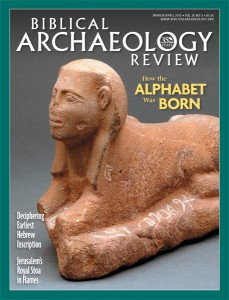
Orit Peleg-Barkat of the Hebrew University has been studying the hundreds of elegant fragments that fell from the Royal Stoa on the herodian Temple Mount in Jerusalem when it was destroyed by the Romans in 70 C.E. In the course of her research, she came across some unusual-looking stones, so she consulted leading Israeli geologist aryeh Shimron to help her understand them. We’ll start with Orit.
The historian Josephus gives us our most detailed description of the Herodian Temple Mount prior to its destruction by the Romans in 70 C.E. Before rebuilding the Second Temple, Herod doubled the size of the previously existing Temple Mount. In the center of the nearly rectangular platform was of course the Temple, facing east.a “To approaching strangers,” writes Josephus, “[the Temple] appeared from a distance like a snow-clad mountain; for all that was not overlaid with gold was of purest white.”1 On the eastern, western and northern borders of the Herodian Temple Mount were lovely columned porticoes.
Already a library member? Log in here.
Institution user? Log in with your IP address.

